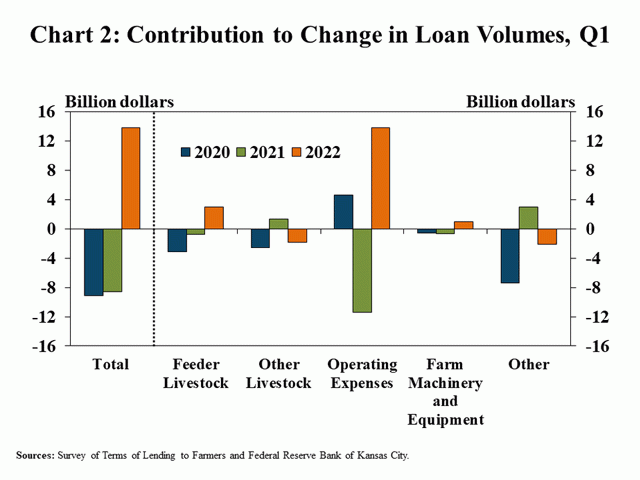Minding Ag's Business
Operating Loan Volumes Swell as Farmers Ask Banks to Help With Rising Input Costs
Farmers turned to their bankers this spring for help with surging input costs. Data from the Federal Reserve Bank of Kansas City's survey of lenders shows that the volume of non-real estate agricultural loans increased sharply from last year, and a record number of operating loans surpassed $1 million.
It's the fastest acceleration of farm lending in four years, economists Nathan Kauffman and Ty Kreitman wrote in a recent report. Lending levels are still modest compared to historical standards and remain below the average of recent years on an inflation-adjusted basis.
"Alongside substantial increases in the prices of key inputs, loans for operating expenses increased sharply and boosted overall lending activity," Kauffman and Kreitman said. "Operating loans increased about 30% from a year ago and accounted for nearly all of the increase in non-real estate loan volumes (Chart 2). Feeder livestock loans also increased at a rapid pace alongside higher livestock prices, but the volume of increase was comparatively smaller."
P[L1] D[0x0] M[300x250] OOP[F] ADUNIT[] T[]
More interestingly, it was the size of the average loan, not the total number of loans, driving the burst of banking activity.
"While the outlook for the U.S. agricultural economy in 2022 remained strong alongside elevated commodity prices, rising input costs have raised concerns about future profitability. The escalation of the Russia-Ukraine conflict and associated market disruptions pushed crop prices even higher. However, the turmoil also led to rapid increases in the prices of major inputs such as fuel and some agricultural fertilizers that are sourced from those countries," the economists wrote.
"While higher crop prices are likely to support farm revenues, concerns about the cost and availability of agricultural inputs intensified and higher feed prices could also pressure profit margins for livestock producers. Higher prices for key farm inputs and broad inflation could also put upward pressure on credit needs moving forward."
You can read the entire report here: https://www.kansascityfed.org/…
Katie Dehlinger can be reached at katie.dehlinger@dtn.com
Follower her on Twitter at @KatieD_DTN
(c) Copyright 2022 DTN, LLC. All rights reserved.






Comments
To comment, please Log In or Join our Community .